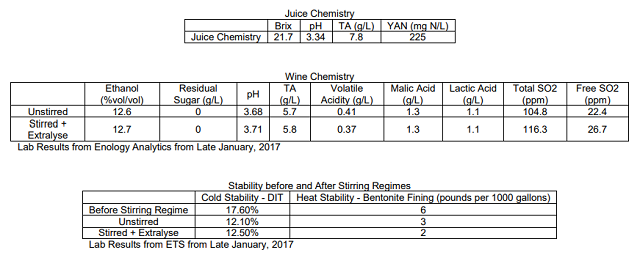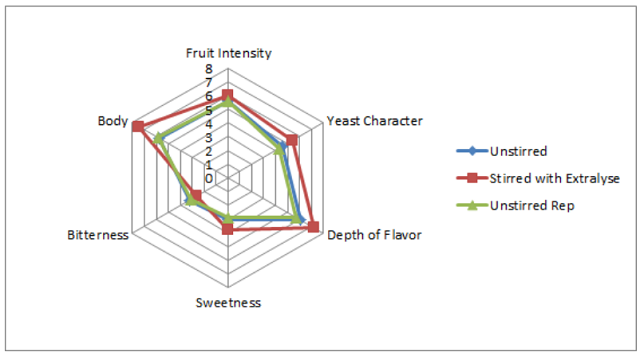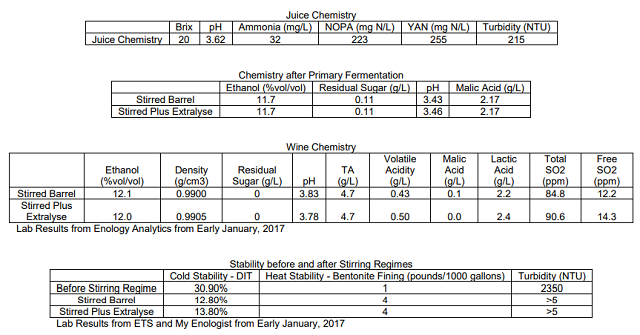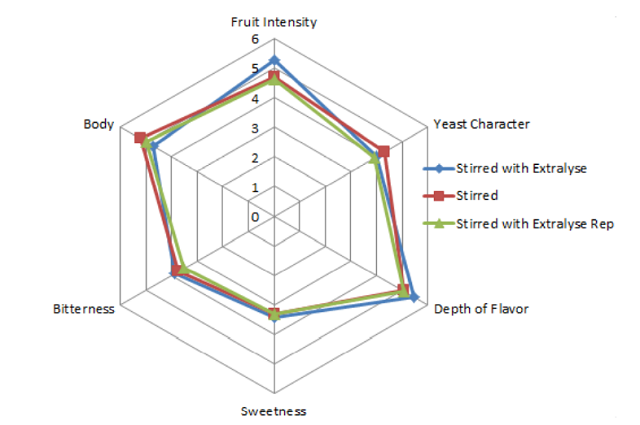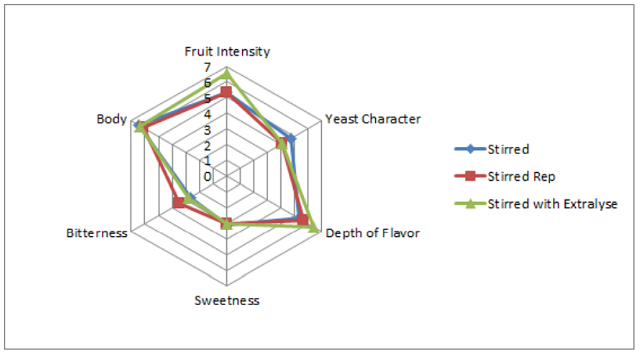Chardonnay Lees Management with Extralyse (ARC)(2016)
Michael Heny
Horton Vineyards
Summary
This study examined the impact of lees stirring and batonnage enzyme addition during Chardonnay aging on the chemical and sensory qualities of the wine. Chardonnay juice was fermented in barrels, and afterwards 3 different stirring regimes were imposed: unstirred, stirred, and stirred with Extralyse (Laffort). Stirring occurred once per week for 8 weeks. The finished wines showed decreasing levels of residual sugar with stirring and with enzyme addition. Some malolactic fermentation could be observed in the stirred wine with Extralyse as well. Wine tended to become more cold stable over time, but the unstirred wine showed the highest level of cold stability but also the highest level of bentonite addition necessary to become heat stable. These results suggest that stirring may enhance Sweetness, Depth of Flavor, Yeast Character, and Body, although many of these effects were weak. The effect of Extralyse in combination with stirring was not too different than from stirring itself. However, the stirring regime for this study was relatively short (8 weeks). In the future, more realistic stirring regimes should be implemented to see whether differences tend to increase over time, particularly with respect to Extralyse.
Introduction
Marchal et al. (2011) provide an excellent brief review of yeast autolysis in their introduction. Lees are mainly composed of yeast, bacteria, tartaric acid, polysaccharides, and protein-tannin complexes (Zoecklein 2013). Heavy lees generally refers to lees which precipitate 24 hours after fermentation (generally grape particles and large complexes of other lees particulates), and can often lead to off-aromas in wine. Light lees precipitate later and are generally beneficial to wine quality, and have less grape particulates and less heavily complexed yeasts and other lees particulates (Zoecklein 2005; Zoecklein 2013). Lees aging can decrease vanilla flavors from oak, and increase toasted flavors (Chatonnet et al. 1992; Tominaga et al. 2000). Others have observed that lees stirring increases yeast character in the wine, decreases fruit and oak character. In some cases, this reduction in oak character can increase the perception of fruit (relative to very oaky control wines) (Zoecklein 2005).
Lees aging also increases the polysaccharide content of wines, particularly mannoproteins, which may enhance wine protein and tartrate stability (Llaubères et al. 1987; Ledoux et al. 1992; Moine-Ledoux et al. 1997; Feuillat 2003; Zoecklein 2005; Zoecklein 2013). Sur lies aging releases mannoproteins and other cell wall polysaccharides which can enhance the colloidal structure, stability, and aromatic quality of red wines while reducing their astringency, making sur lie aging of red wines important (Zoecklein 2005). Although yeast-derived proteins can increase during lees aging, these proteins are not involved in protein instability (Zoecklein 1991).
Lees may also act to preserve fruity and varietal characteristics by preventing oxidation and producing a reducing environment (Marchal et al. 2011; Zoecklein 2013). The release of thiols into the wine from yeast has been attributed to lowering reductive characteristics by being able to oxidize methanethiol and ethanethiol into their non-volatile disulfide forms (Lavigne and Dubourdieu 1996); however, this greatly depends on other factors in the aging process, and could impart a more reductive character to the wine. Yeast glycoproteins from autolysis may also decrease astringency in wines through interaction with phenolic compounds (Escot et al. 2001). Lees autolysis can also impart sweetness to wine (Zoecklein 2005; Marchal et al. 2001), which may be in part due to sweet peptide fractions released during cell autolysis. One such fraction appears to be derived from heat shock proteins (Hsp12p) (Marchal et al. 2011), which is expressed from high temperature, ethanol, oxidative stress, and glycerol concentrations (Varela et al. 1995). All of these factors are present under winemaking conditions (Marchal et al. 2011). The breakdown of peptides can result in aromatic precursors in wines (Zoecklein 2005), but may also provide more nitrogen for spoilage organisms to consume. Many of these impacts of lees aging can be affected by winemaking practices, such as frequency of stirring, amount of lees present, amount of oxygen ingress, pectinase/glucosidase enzyme additions (such as Extralyse by Laffort), and perhaps even quality of lees. This study examines the impact of one such lees stirring regime on the chemical and sensory qualities of wine.
Results and Discussion
The finished wines showed decreasing levels of residual sugar with stirring and with enzyme addition. Some malolactic fermentation could be observed in the stirred wine with Extralyse as well. Wine tended to become more cold stable over time, but the unstirred wine showed the highest level of cold stability but also the highest level of bentonite addition necessary to become heat stable. This increase in heat stability agrees with results seen by Ledoux et al. 1992, but the tartrate stability decrease disagrees with results obtained by Moine-Ledoux et al. 1997. By 10/20, the barrels had a strange aroma (lacked fruitiness), and instead was described by the winemaker as stinky, gluey, butterscotch, with a Burgundian character. The strange aroma in this wine may have originated from Captan fungicide residue, although this has not been confirmed.
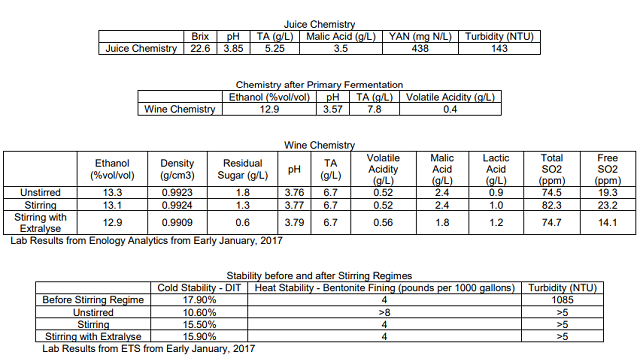
The wine was tasted at two different sensory sessions. At the January 25 session at Early Mountain Vineyards, no real preference trend could be observed (Table 1). The comments made on these wines suggest a strong oak presence, especially in the stirred wines.

There was a strong trend for the Stirred wine to have higher Sweetness scores than the unstirred wine for the January 25 tasting session. This could correspond to the general characterization of the stirred wines as being oaky by the judges. However, the stirred wine with Extralyse was only weakly scored as being sweeter than the unstirred wine. In general, stirred wines had a slight tendency to have more Yeast Characteristics, more Body, and more Sweetness.
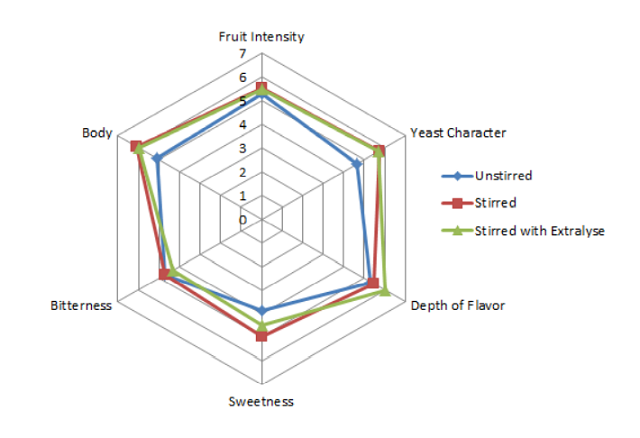
In the February 15 session at Williamsburg Winery, there was no preference for any of the kinds of stirring regimes.

No strong trends were found for the descriptors used in this study on the February 15 tasting. No major trends could be observed in these wines as well, except that stirring tended to increase Body.
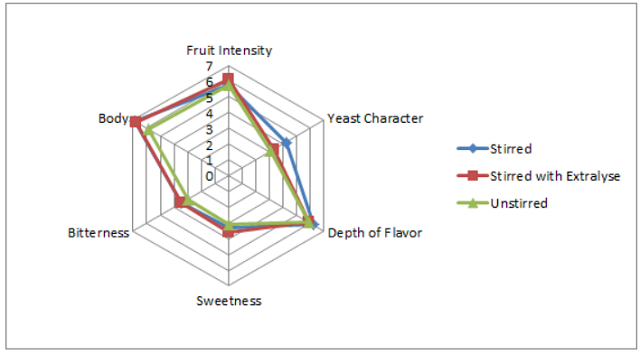
These results suggest that stirring may enhance Sweetness, Depth of Flavor, Yeast Character, and Body, although many of these effects were not strong. The effect of Extralyse in combination with stirring was not too different than from stirring itself. However, the stirring regime for this study was relatively short (8 weeks). In the future, more realistic stirring regimes should be implemented to see whether differences tend to increase over time, particularly with respect to Extralyse.
Methods
7.5 tons of identically sourced Chardonnay grapes from Silver Creek Vineyard (Glen Anne, 3 year old vines) were hand harvested on 9/15/16, chilled overnight then whole cluster pressed. The juice received 30 ppm Sulfur dioxide and 30 mls/ton Color Pro enzyme. Tartaric acid was added as needed to adjust the pH to 3.44. Following cold settling (9/18) the juice was racked off of lees to 143 NTUs and inoculated with 25 g/hl CY3079 to reach a fermentation NTU of 195. Following lag phase, when the fermentation had begun (9/20), the juice was aeratively racked with lees inclusion to barrels and an NTU of 110 in order to homogenize and aerate for barrel fermentation. Each treatment was in 4 barrels.
Following alcoholic fermentation (10/17), barrels were stabilized with 50ppm sulfur dioxide, topped, and samples from each treatment were taken and sent off for cold stability and heat stability analysis. Since each treatment had 4 barrels, these samples were taken by mixing equal sample volumes from each barrel belonging to a specific treatment. On 10/20, to a trial lot of 4 barrels, 6 g/hl of Extralyse was added. The control and trial were stirred 1 time per week with a stainless steel “baton”, using 6 to 8 strokes until the lees were back in suspension. A set of barrels was left unstirred. The NTUs at the beginning of the stirring regime was 1097 NTU in the barrel with Extralyse, and 1085 NTU in the barrel that was stirred (ARC wanted a target of 2000-3000 NTU). All barrels received 50 ppm SO2on 12/7.
Post-Fermentation heat and cold stability were performed by ETS. All cold stability trials on finished wine from the second set of barrels was performed by My Enologist. All general wine chemistry on finished wine was performed by Enology Analytics. The rest of the results were gathered in-house.
In order to balance the data set to perform statistical descriptive analysis on the January 25 tasting, any judge who had not fully completed the descriptive analysis ratings were removed. In order to then make the amount of judges between groups equivalent, one judge from group 1 was transferred to group 2. This resulted in a final data set of 3 groups, each with 10 judges (considered as replications within groups, and groups were considered as assessors). Data was analyzed using Panel Check V1.4.2. Because this is not a truly statistical set-up, any results which are found to be statistically significant (p<0.05) will be denoted as a “strong trend” or a “strong tendency,” as opposed to general trends or tendencies. The statistical significance here will ignore any other significant effects or interactions which may confound the results (such as a statistically significant interaction of Judge x Wine confounding a significant result from Wine alone). The descriptors used in this study were Fruit Intensity, Yeast Character, Depth of Flavor, Sweetness, Bitterness, and Body.
The procedures for analyzing sensory analysis were the same for the February 15 tasting. For descriptive analysis, in order to balance the data set one judge from group 1 was assigned to group 2, resulting in 3 groups each with 3 judges.
References
Chatonnet, P., Dubourdieu, D., and Boidron, J. N. 1992. Incidence des conditions de fermentation et d’èlevage des vins blancs secs en barriques sur leur composition en substances cèdèes par le bois de chêne. Sci. Aliments. 12:665–685.
Escot, S., Feuillat, M., Dulau, L., and Charpentier, C. 2001. Release of polysaccharides by yeasts and the influence of released polysaccharides on colour stability and wine astringency. Aust. J. Grape Wine Res. 7:153–159.
Feuillat, M. 2003. Yeast macromolecules: Origin, composition, and enological interest. Am. J. Enol. Vitic. 54:211-213.
Lavigne, V. and Dubourdieu, D. 1996. Demonstration and interpretation of the yeast lees ability to adsorb certain volatile thiols contained in wine. J. Int. Sci. Vigne Vin. 30:201–206.
Ledoux, V., Dulau, L., and Dubourdieu, D. 1992. Interprètation de l’amèlioration de la stabilitè protèique des vins au cours de l’èlevage sur lies. J. Int. Sci. Vigne Vin. 26:239–251
Llaubères, R.-M., Dubourdieu, D., and Villettaz, J.-C. 1987. Exocellular polysaccharides from Saccharomyces in Wine. J. Sci. Food Agric. 41:277–286.
Marchal, A., Marullo, P., Moine, V., and Dubourdieu, D. 2011. Influence of yeast macromolecules on sweetness in dry wines: role of the Saccharomyces cerevisiae protein Hsp12. Journal of Agricultural and Food Chemistry. 59:2004-2010.
Moine-Ledoux, V., Perrin, A., Paladin, I., and Dubourdieu, D. 1997. Premiers rèsultats de stabilisation tartrique des vins par addition de mannoprotèines purifièes (Mannostab). J. Int. Sci. Vigne Vin. 31:23–31.
Tominaga, T., Blanchard, L., Darriet, P., and Dubourdieu, D. 2000. A powerful aromatic volatile thiol, 2-furanmethanethiol, exhibiting roast coffee aroma in wines made from several Vitis vinifera grape varieties. J. Agric. Food Chem. 48:1799–1802.
Varela, J. C. S., Praekelt, U. M., Meacock, P. A., Planta, R. J., and Mager, W. H. 1995. The Saccharomyces cerevisiae HSP12 gene is activated by the high- osmolarity glycerol pathway and negatively regulated by protein kinase A. Mol. Cell. Biol. 15:6232–6245.
Zoecklein, B. 1991. Protein stability determination in juice and wine. Virginia Cooperative Extension. http://www.apps.fst.vt.edu/extension/enology/downloads/ProteinS.pdf.
Zoecklin, B. 2005. Lees Management. Enology Notes #106. http://www.apps.fst.vt.edu/extension/enology/EN/106.html.
Zoecklein, B. 2013. Nature of wine lees. Practical Winery and Vineyard. July. http://www.apps.fst.vt.edu/extension/enology/downloads/wm_issues/Nature%20of%20Wine%20Lees.pdf.

